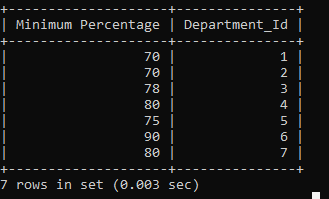SQL GROUP BY CLAUSE
The GROUP BY clause is used to arrange similar records into the groups in the Structured Query Language queries. The records are arranged with the help of functions which is equivalent to each other.
We can use the GROUP BY clause with the SELECT query in the Structured Query Language. We placed the GROUP BY clause after the WHERE clause and before the ORDER BY clause in the SQL queries.
The syntax for the SQL GROUP BY clause is:
SELECT * FROM Table_Name GROUP BY Column_Name;
The above syntax will select all the data or records from the table name mentioned, and it will arrange all those data or records in the group by column name.
The syntax for SQL GROUP BY clause with a specific column is given below:
SELECT Column_Name_1, Column_Name_2, Column_Name_3, Column_Name__4, Column_Name__5 FROM Table_Name GROUP BY Column_Name;
The above syntax will display records of selective columns only and arrange those column data in the group.
The GROUP BY clause specially used with the aggregate function i.e. max(), min(), avg(), sum(), count() to group result by one or more than one columns.
The below syntax is used by the SQL GROUP BY clause using Aggregate Functions is as follows:
SELECT Column_Name_1, Function_Name(Column_Name) FROM Table_Name GROUP BY Column_Name;
Let’s understand the SQL GROUP BY Clause with the help of an example.
Consider the already existing table with the following data:
Table Name: Employee_Details
| E_Id | E_Name | E_Salary | E_City | Designation | Age |
| 1001 | Kirti Kirtane | 60000 | Mumbai | Project Manager | 26 |
| 1002 | Akash Vani | 40000 | Pune | System Engineer | 22 |
| 1003 | Anupam Mishra | 55000 | Hyderabad | Project Manager | 25 |
| 1004 | Anuj Rawat | 45000 | Hyderabad | Software Tester | 25 |
| 1005 | Akanksha Yadav | 42000 | Pune | Associate Software Developer | 23 |
| 1006 | Bhavesh Wani | 50000 | Mumbai | Associate Software Developer | 24 |
| 2001 | Sakshi Sharma | 40000 | Bangalore | System Engineer | 23 |
| 2002 | Megha Ghatole | 45000 | Bangalore | Software Tester | 24 |
| 2003 | Surbhi Nahar | 60000 | Pune | Project Manager | 26 |
| 2004 | Supriya Shende | 55000 | Mumbai | Software Developer | 25 |
| 2005 | Prachi Sharma | 52000 | Hyderabad | Software Developer | 24 |
| 2006 | Purva Dhandekar | 50000 | Bangalore | Software Tester | 23 |
| 3001 | Shruti Deshpande | 60000 | Pune | Project Manager | 26 |
| 3002 | Rohit Nikam | 40000 | Hyderabad | System Engineer | 23 |
| 3003 | Sahil Jain | 50000 | Mumbai | Software Developer | 24 |
Example 1: Write a query to display employee’s details group by age column
SELECT * FROM Employee_Details GROUP BY Age;
The above query will display all the records of the Employee_Details table group by age column.
The output of the above query is as follows:
| E_Id | E_Name | E_Salary | E_City | Designation | Age |
| 1002 | Akash Vani | 40000 | Pune | System Engineer | 22 |
| 1005 | Akanksha Yadav | 42000 | Pune | Associate Software Developer | 23 |
| 1006 | Bhavesh Wani | 50000 | Mumbai | Associate Software Developer | 24 |
| 1003 | Anupam Mishra | 55000 | Hyderabad | Project Manager | 25 |
| 1001 | Kirti Kirtane | 60000 | Mumbai | Project Manager | 26 |

Example 2: Write a query to display employee’s details group by Salary, and Designation column
SELECT * FROM Employee_Details GROUP BY E_Salary, Designation;
The above query will display all the records of the Employee_Details table group by Salary and Designation column.
The output of the above query is as follows:
| E_Id | E_Name | E_Salary | E_City | Designation | Age |
| 1002 | Akash Vani | 40000 | Pune | System Engineer | 22 |
| 1005 | Akanksha Yadav | 42000 | Pune | Associate Software Developer | 23 |
| 1004 | Anuj Rawat | 45000 | Hyderabad | Software Tester | 25 |
| 1006 | Bhavesh Wani | 50000 | Mumbai | Associate Software Developer | 24 |
| 3003 | Sahil Jain | 50000 | Mumbai | Software Developer | 24 |
| 2006 | Purva Dhandekar | 50000 | Bangalore | Software Tester | 23 |
| 2005 | Prachi Sharma | 52000 | Hyderabad | Software Developer | 24 |
| 1003 | Anupam Mishra | 55000 | Hyderabad | Project Manager | 25 |
| 2004 | Supriya Shende | 55000 | Mumbai | Software Developer | 25 |
| 1001 | Kirti Kirtane | 60000 | Mumbai | Project Manager | 26 |
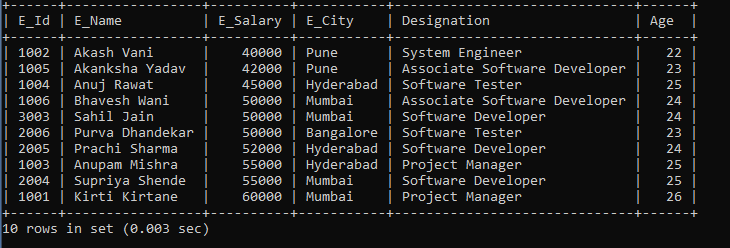
Example 3: Write a query to display employee’s details group by Salary column in the ascending order by Employee name.
SELECT * FROM Employee_Details GROUP BY E_Salary ORDER BY E_Name;
The above query will display all the records of the Employee_Details table group by Salary column in the ascending order by employee name.
The output of the above query is:
| E_Id | E_Name | E_Salary | E_City | Designation | Age |
| 1005 | Akanksha Yadav | 42000 | Pune | Associate Software Developer | 23 |
| 1002 | Akash Vani | 40000 | Pune | System Engineer | 22 |
| 1004 | Anuj Rawat | 45000 | Hyderabad | Software Tester | 25 |
| 1003 | Anupam Mishra | 55000 | Hyderabad | Project Manager | 25 |
| 1006 | Bhavesh Wani | 50000 | Mumbai | Associate Software Developer | 24 |
| 1001 | Kirti Kirtane | 60000 | Mumbai | Project Manager | 26 |
| 2005 | Prachi Sharma | 52000 | Hyderabad | Software Developer | 24 |

Now, let’s understand the GROUP BY clause using the aggregate function with the help of an example
Consider the already existing table with the following data:
Table Name: Diploma_Students
| Student_Id | Student_Name | First_Sem | Second_Sem | Third_Sem | Fourth_Sem | Fifth_Sem | Sixth_Sem | Total | Department_Id |
| 202111 | Vaishnavi Patil | 94 | 91 | 88 | 85 | 95 | 92 | 91 | 6 |
| 202112 | Vaibhav Lokhande | 85 | 90 | 92 | 80 | 85 | 82 | 86 | 2 |
| 202113 | Yash Dhull | 90 | 88 | 94 | 87 | 85 | 90 | 89 | 3 |
| 202114 | Sonali Patole | 95 | 90 | 92 | 88 | 92 | 90 | 91 | 4 |
| 202115 | Axar Patel | 85 | 80 | 82 | 86 | 92 | 84 | 85 | 1 |
| 202116 | Meena Mishra | 78 | 75 | 80 | 74 | 85 | 77 | 78 | 3 |
| 202117 | Mahesh Kumbhar | 75 | 80 | 75 | 78 | 80 | 76 | 77 | 5 |
| 202118 | Sakshi Patil | 80 | 78 | 74 | 78 | 80 | 77 | 78 | 2 |
| 202119 | Sopan Bhore | 70 | 68 | 75 | 75 | 80 | 80 | 75 | 2 |
| 202220 | Prajwal Lokhande | 80 | 85 | 85 | 75 | 78 | 80 | 81 | 4 |
| 202221 | Anuja Wanare | 85 | 88 | 86 | 82 | 84 | 85 | 85 | 7 |
| 202222 | Venkatesh Iyer | 90 | 89 | 87 | 90 | 92 | 91 | 90 | 3 |
| 202223 | Anushka Sen | 70 | 75 | 71 | 74 | 80 | 78 | 75 | 1 |
| 202224 | Aakash Jain | 80 | 75 | 72 | 74 | 85 | 80 | 78 | 7 |
| 202225 | Akshay Agarwal | 85 | 80 | 78 | 88 | 90 | 82 | 84 | 7 |
| 202226 | Shwetali Bhagwat | 90 | 80 | 85 | 88 | 90 | 80 | 86 | 6 |
| 202227 | Mayuri Wagh | 80 | 80 | 85 | 80 | 82 | 85 | 82 | 4 |
| 202228 | Utkarsh Rokade | 85 | 80 | 80 | 90 | 84 | 84 | 84 | 5 |
| 202229 | Manthan Koli | 85 | 75 | 84 | 78 | 82 | 80 | 81 | 2 |
| 202230 | Mayur Jain | 80 | 88 | 87 | 90 | 92 | 90 | 88 | 1 |
Example 1: Write a query to display the total number of student percentages scored in the First-Semester, and Second-Semester column GROUP BY First-Semester, and Second-Semester column
SELECT Count(Student_Name) AS 'Total Number', First_Sem, Second_Sem FROM Diploma_Student GROUP BY First_Sem, Second_Sem;
The above query displays how many students scored percentages in the first-semester, second-semester GROUP BY first-semester, and second-semester.
The output of the above query is as follows:
| Total Number | First_Sem | Second_Sem |
| 1 | 70 | 68 |
| 1 | 70 | 75 |
| 1 | 75 | 80 |
| 1 | 78 | 75 |
| 1 | 80 | 75 |
| 1 | 80 | 78 |
| 1 | 80 | 80 |
| 1 | 80 | 85 |
| 1 | 80 | 88 |
| 1 | 85 | 75 |
| 3 | 85 | 80 |
| 1 | 85 | 88 |
| 1 | 85 | 90 |
| 1 | 90 | 80 |
| 1 | 90 | 88 |
| 1 | 90 | 89 |
| 1 | 94 | 91 |
| 1 | 95 | 90 |
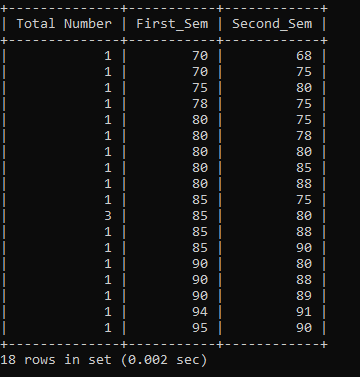
Example 2: Write a query to sum the student total column percentage group by Department id.
SELECT SUM(Total) AS 'Total', Department_Id FROM Diploma_Student GROUP BY Department_Id;
We summed the student total column group by department id in the above query.
The output of the above query is as follows:
| Total | Department_Id |
| 248 | 1 |
| 320 | 2 |
| 257 | 3 |
| 254 | 4 |
| 161 | 5 |
| 177 | 6 |
| 247 | 7 |
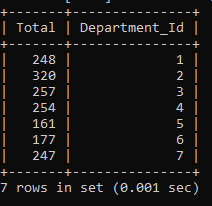
Example 3: Write a query to display the maximum total column percentage of the student GROUP BY Department id.
SELECT MAX(Total) as 'Maximum Percentage', Department_Id FROM Diploma_Student GROUP BY Department_Id;
In the above query, we displayed the maximum student percentage of the total column GROUP BY Department Id
The output of the above query is as follows:
| Maximum Percentage | Department_Id |
| 88 | 1 |
| 86 | 2 |
| 90 | 3 |
| 91 | 4 |
| 84 | 5 |
| 91 | 6 |
| 85 | 7 |
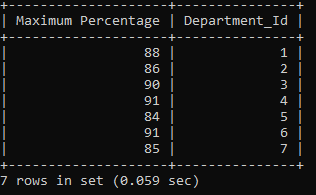
Example 4: Write a query to display the minimum first-semester column percentage of the student GROUP BY Department id.
SELECT MIN(First_Sem) as 'Minimum Percentage', Department_Id FROM Diploma_Student GROUP BY Department_Id;
In the above query, we displayed the minimum student percentage of the first-semester column GROUP BY Department Id
The output of the above query is as follows:
| Minimum Percentage | Department_Id |
| 70 | 1 |
| 70 | 2 |
| 78 | 3 |
| 80 | 4 |
| 75 | 5 |
| 90 | 6 |
| 80 | 7 |
